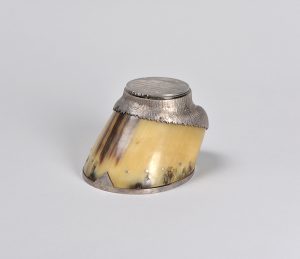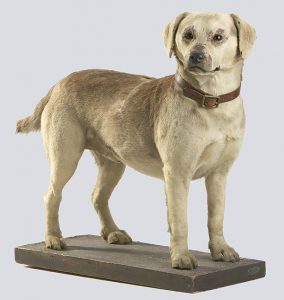Animals in War and Art
The Various Functions of Animals in the Military
Animals have a long history of involvement in the military. Some animals are morale-boosting mascots and companions and some are tools to aid in communication and transportation. Others are helpmates in the hard physical work involved in war.
These animals have a complex and continual interaction with military personnel. Because of this, it is not surprising that soldiers depicted animals on their war-related crafts. Animal mascots are common subject matter for painted depictions. They appear on mess walls, ship exhaust funnels, and even individual kit bags.

A navy kit bag painted by a soldier depicting a ship’s mascot; likely a dog named Freckles (canvas, paint, 162.6 x 226.1 cm, Second World War).
Animals as Mascots: Dogs on Ships and Navy Kits
Many Royal Canadian Navy ships of both World Wars, for example, had animal mascots that lived on board. These animals were beloved and embraced by naval officers that served with them. The presence of these animals would appear on various items made or altered by officers.
There is, for example, a navy kit bag that depicts a ship’s mascot. This dog is likely Freckles, the Springer Spaniel mascot on the HMCS Atholl, a corvette that served as an escort to convoys crossing the Atlantic Ocean.
Dogs also took on a special role with the army. During the Second World War, the Royal Scottish Regiment had a St. Bernard as a mascot. Upon its passing, the soldiers memorialized the dog by having it cremated and placed in an ornate, silver urn.
The Special Case of Paddy
It was uncommon for regiments to have an entire dog or horse preserved by a taxidermist.
One example was a dog named Paddy. He “joined” the 4th Field Ambulance Corps while they were training for the First World War at the exhibition grounds in Calgary. He disembarked by train with the rest of the Corps in Halifax, and crossed the Atlantic in a troop ship. He arrived in England on April 28th, 1915.
After training in England, the troops were sent to Belgium and France where they were involved in the battles of St. Eloi, the Somme, Vimy Ridge, Hill 70 and Passchendaele. Paddy was with them through it all.
After the war ended, the soldiers wanted to bring Paddy home. Unfortunately, he was not allowed on board the ship. As a result, they took him to a taxidermist in England.
Paddy was such a meaningful animal to the troops with whom he served. These soldiers brought his effigy to all their reunions. And, in 1972, the soldiers donated him to the Glenbow Museum in Calgary.
Horses on Battlefields and Desktops
In the army, up to and including the First World War, cavalry officers rode horses. At that time, it was common to make a memento out of the hoof of a favourite horse when it passed on. These mementos could take the form of ashtrays or inkwells. They were usually inscribed with a tribute to the individual horse.
These types of objects are evidence of how a real fondness existed between an officer and his horse. For example, Raymond Theodore Pelly served in the Boer War in South Africa. He went on to become a Lieutenant Colonel with the Princess Patricia’s Canadian Light Infantry (PPCLI) during the First World War. After the war, the army presented him with an inkwell made from the hoof of his horse, Maxie.

An inkwell made from a horse’s hoof with inscription on lid – MAXIXE CHARGER OF LIEUT. COL. R.T. PELLY D.S.O. COMMANDING PRINCESS PATRICIA’S CANADIAN LIGHT INFANTRY, DURING THE GREAT WAR 1914–1918.(silver, hoof, metal, glass, 7.5 x 13.7 x 10.2 cm, 1918).
The Social Purpose of Memorialization
Memorializing devoted mascots and pets symbolically safeguards the qualities of loyalty and devotion that well- treated animals so consistently display. Mascots are also a symbol of the collective group, and preserving and memorializing them honours the entire group.
If you would like to see more trench art and other Canadian war-related craft, click here.


